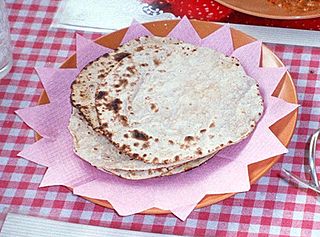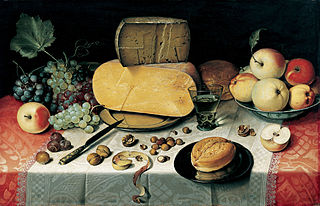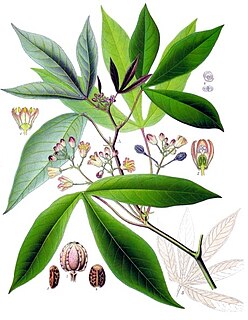
Tapioca is a starch extracted from the storage roots of the cassava plant. This species is native to the north region and central-west region of Brazil, but its use spread throughout South America. The plant was carried by Portuguese and Spanish explorers to most of the West Indies and Africa and Asia. It is a perennial shrub adapted to the hot conditions of tropical lowlands. Cassava copes better with poor soils than many other food plants.

Malaysian cuisine consists of cooking traditions and practices found in Malaysia, and reflects the multiethnic makeup of its population. The vast majority of Malaysia's population can roughly be divided among three major ethnic groups: Malays, Chinese and Indians. The remainder consists of the indigenous peoples of Sabah and Sarawak in East Malaysia, the Orang Asli of Peninsular Malaysia, the Peranakan and Eurasian creole communities, as well as a significant number of foreign workers and expatriates.
Jamaican cuisine includes a mixture of cooking techniques, flavours, spices and influences from the indigenous people on the island of Jamaica, and the Spanish, Irish, British, Africans, Indian and Chinese who have inhabited the island. It is also influenced by the crops introduced into the island from tropical Southeast Asia. Jamaican cuisine includes various dishes from the different cultures brought to the island with the arrival of people from elsewhere. Other dishes are novel or a fusion of techniques and traditions. In addition to ingredients that are native to Jamaica, many foods have been introduced and are now grown locally. A wide variety of seafood, tropical fruits and meats are available.

Khmer cuisine or, more generally, Cambodian cuisine, is the traditional cuisine of the people of Cambodia. Average meals typically consist of more than one dish and ideally contrast flavours, textures and temperatures within the meal using plenty of herbs, leaves, pickled vegetables, dipping sauces, edible flowers and other garnishes and condiments.

Colocasia esculenta is a tropical plant grown primarily for its edible corms, the root vegetables most commonly known as taro. It is the most widely cultivated species of several plants in the Araceae family which are used as vegetables for their corms, leaves, and petioles. Taro corms are a food staple in African, Oceanic and South Asian cultures, and taro is believed to have been one of the earliest cultivated plants.
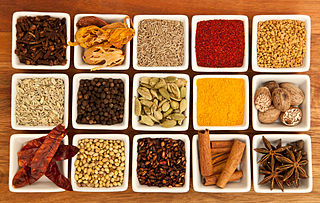
Tamil cuisine is a cuisine native to the Tamil people who are native to the Indian state of Tamil Nadu and northern Sri Lanka. It is also the cuisine of the Tamil-speaking population of Karnataka, Kerala and Andhra Pradesh in India and of the Tamil communities of Singapore, Malaysia, and Indonesia.

Nsima is a type of cornmeal porridge made in Africa. It is also known as ngima,'obusuma'nshima, Mieliepap, phutu, sadza, and other names. It is sometimes made from other flours, such as millet or sorghum flour, and is sometimes mixed with cassava flour. It is cooked in boiling water or milk until it reaches a stiff or firm dough-like consistency.

Cameroonian cuisine is one of the most varied in Africa due to its location on the crossroads between the north, west, and center of the continent; the diversity in ethnicity with mixture ranging from Bantus, Semi-bantus and Shua-Arabs. Added to this is the influence of German colonialisation and later the French and English annexation of different parts of the country.

Ugandan cuisine consists of traditional and modern cooking styles, practices, foods and dishes in Uganda, with English, Arab, and Asian influences.

The cuisine of the Democratic Republic of the Congo varies widely, representing the food of indigenous people. Cassava is generally the staple food usually eaten with other side dishes.

Ghanaian cuisine is the cuisine of the Ghanaian people. Ghanaian main dishes are organized around a starchy staple food, with which goes a sauce or soup containing a protein sauce. The main ingredient for the vast majority of soups and stews are tomatoes- canned or fresh tomatoes can be used. As a result, nearly all Ghanaian soups and stews are red or orange in appearance.

South Indian cuisine includes the cuisines of the five southern states of India—Andhra Pradesh, Karnataka, Kerala, Tamil Nadu and Telangana—and the union territories of Lakshadweep, Pondicherry, and the Andaman and Nicobar Islands.

Sierra Leonean cuisine consists of the cooking traditions and practices from Sierra Leone. It follows the traditions of other West African cuisines.

[[File:Yam pottage.jpg|thumb|A yam porridge

Javanese cuisine is the cuisine of Javanese people, a major ethnic group in Indonesia, more precisely the province of Central Java, Yogyakarta and East Java. Though the cuisine of Sumatra is known for its spiciness with notable Indian and Arabic influences, Javanese cuisine is more indigenously developed and noted for its simplicity. Some of Javanese dishes demonstrate foreign influences, most notably Chinese.
Belizean cuisine is an amalgamation of all ethnicities in the nation of Belize and their respectively wide variety of foods. Breakfast often consists of sides of bread, flour tortillas, or fry jacks that are often homemade and eaten with various cheeses. All are often accompanied with refried beans, cheeses, and various forms of eggs, etc. Inclusive is also cereal along with milk, coffee, or tea.
A great variety of cassava-based dishes are consumed in the regions where cassava is cultivated, and they include many national or ethnic specialities.
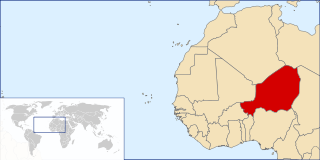
The cuisine of Niger takes after many traditional African cuisines, and a significant amount of spices are used in dishes. Grilled meat, seasonal vegetables, salads and various sauces are some of the foods consumed.

A staple food, food staple, or simply a staple, is a food that is eaten routinely and in such quantities that it constitutes a dominant portion of a standard diet for a given people, supplying a large fraction of energy needs and generally forming a significant proportion of the intake of other nutrients as well. A staple food of a specific society may be eaten as often as every day or every meal, and most people live on a diet based on just a small number of food staples. Specific staples vary from place to place, but typically are inexpensive or readily available foods that supply one or more of the macronutrients needed for survival and health: carbohydrates, proteins, and fats. Typical examples include tubers and roots, grains, legumes, and seeds.

